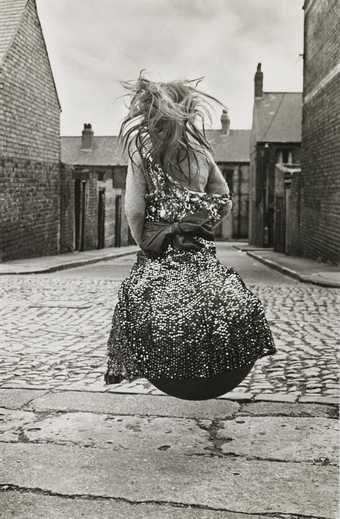
Sirkka-Liisa Konttinen
Girl on a Spacehopper (Byker) (1971, printed 2012)
Tate
Tate Britain has opened its latest series of new free displays, each focusing on specific artists and subjects, including works from across the centuries by William Blake, John Singer Sargent, Marie Yates and John Akomfrah. Located throughout the chronological Walk Through British Art and in the Clore Gallery, these Spotlight displays offer an in-depth look at particular artists, themes and moments in history. They can all be visited for free, either by picking up a collection ticket on arrival at Tate Britain or by booking in advance at tate.org.uk/britain.
Poetical Bodies: Works on Paper by Blake and His Contemporaries (open until 10 April 2022)
This display focuses on William Blake and several of his contemporaries. These artists studied human form, movement, character and expression but applied this knowledge to unconventional, visionary scenes. Gods, heroes, demons and monsters populate their drawings and prints, arising from their imaginations as well as myth, literature and history. They looked to the art of the past, but also used topical incidents as inspiration, caricaturing and transforming contemporary public figures.
John Singer Sargent: Wertheimer Portraits (open until 24 July 2022)
This display brings together portraits from the Wertheimer bequest by John Singer Sargent and is the first time these portraits are being shown as a standalone group at Tate. Asher Wertheimer (1843–1918), a highly successful London art dealer, commissioned Sargent to paint the series, which forms the artist’s largest commission. Nine of them were donated to the national art collection, a gift which sparked controversy at a time when only aristocratic families traditionally commissioned portraits of this scale.
Isabel Rawsthorne and Alberto Giacometti: a conversation: (open until 25 September 2022)
This display reveals an artistic and romantic conversation between the sculptor Alberto Giacometti and the painter Isabel Rawsthorne through Paris in the 1930s to London in the 1960s. Giacometti’s portraits are well known, especially his mysterious interpretations of ‘Isabel’, becoming thinner and more elusive as they were separated by the dangers of the Second World War. But this is the first time that Rawsthorne’s portraits of humans and animals have been put on display at Tate, revealing a passionate conversation between the two artists about the elusiveness of living presence, in art, life and death.
After Industry: Communities in Northern England 1960s-80s (open until 30 October 2022)
After Industry presents a range of photographers from the Tate collection, including Shirley Baker, Sirkka-Liisa Konttinen, Peter Mitchell, Tish Murtha and Chris Killip. Also included is a film by Sirkka Liisa-Konttinen and Amber Film & Photography collective of life in Newcastle in early 1980s as well as photobooks from Tate's library and archive. The photographers and filmmakers included used social documentary practices to record the lives of communities in northern England during a period of socio-economic upheaval and deindustrialisation.
Marie Yates: The Only Woman (open until 30 October 2022)
Using photomontage, artist Marie Yates reflects on her mourning process over the death of her mother. Described as a feminist art project, her four-part photographic installation references Sigmund Freud’s tracings of the mourning process: Pain, Rage, and Gaze, and a further one – Continuum. The sections reflect Yates’s own stages of grief through her use of photomontage, with short texts taken from her journal entries of the time, resembling news headlines.
Sixty Years: The Unfinished Conversation (open until 2 April 2023)
This is the latest iteration of Tate Britain’s large-scale contemporary collection displays. It explores the evolving nature of diasporic identity through art from Tate’s collection, seeking to present a sense of pluralism - that all identities, beliefs and differences are accepted, respected and ongoing. Based around John Akomfrah’s film work The Unfinished Conversation 2012, the display features works which defy predetermined or fixed notions of identity. Collective memory and networks forged within and across groups connect the artists featured here, exploring themes such as migration, marginalisation, kinship, celebration, healing and resilience.
